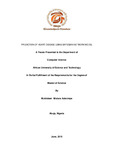Browsing by Subject "artificial intelligence"
Now showing items 1-20 of 22
-
ARLO: Another Representation Language Offer
(1986-10-01)This paper describes ARLO, a representation language loosely modelled after Greiner and Lenant's RLL-1. ARLO is a structure-based representation language for describing structure-based representation languages, including ...
-
Artificial Intelligence and Robotics
(1984-02-01)Since Robotics is the field concerned with the connection of perception to action, Artificial Intelligence must have a central role in Robotics if the connection is to be intelligent. Artificial Intelligence addresses ...
-
Cognitive Security for Personal Devices
(2008-03-17)Humans should be able to think of computers as extensions of their body, as craftsmen do with their tools. Current security models, however, are too unlike those used in human minds---for example, computers authenticate ...
-
CogSci to AI: It's the Brainware, Stupid!
(2006-03)Current modularization techniques fail when applied to hard AI problems.But cognitive science shows that the mind has modules specialized for particular functions.Unlike current engineered modules, the modules of themind ...
-
The Computational Approach to Vision and Motor Control
(1985-08-01)Over the past decade it has become increasingly clear that to understand the brain, we must study not only its biochemical and biophysical mechanisms and its outward perceptual and physical behavior. We also must study ...
-
Design Issues in Parallel Architecture for Artificial Intelligence
(1983-11-01)Development of highly intelligent computers requires a conceptual foundation that will overcome the limitations of the von Neumann architecture. Architectures for such a foundation should meet the following design ...
-
Developmental Cost for Models of Intelligence
(2007-05-15)We can evaluate models of natural intelligence, as well as theirindividual components, by using a model of hardware and developmentcosts, ignoring almost all the details of biology. The basic argumentis that neither the ...
-
Heterarchy in the M.I.T. Robot
(MIT Artificial Intelligence Laboratory, 1971-03)
-
Learning and Invariance in a Family of Hierarchical Kernels
(2010-07-30)Understanding invariance and discrimination properties of hierarchical models is arguably the key to understanding how and why such models, of which the the mammalian visual system is one instance, can lead to good ...
-
Learning by Augmenting Rules and Accumulating Censors
(1982-05-01)This paper is a synthesis of several sets of ideas: ideas about learning from precedents and exercises, ideas about learning using near misses, ideas about generalizing if-then rules, and ideas about using censors to ...
-
Learning by Learning To Communicate
(2007-08-23)Human intelligence is a product of cooperation among many different specialists. Much of this cooperation must be learned, but we do not yet have a mechanism that explains how this might happen for the "high-level" agile ...
-
Notes on the Shannon Entropy of the Neural Response
(2009-10-09)In these notes we focus on the concept of Shannon entropy in an attempt to provide a systematic way of assessing the discrimination properties of the neural response, and quantifying the role played by the number of layers ...
-
The Object Partition Problem
(MIT Artificial Intelligence Laboratory, 1971-02)
-
Prediction of Heart Disease using Bayesian Network Model
(2019-06-16)The Heart Disease according to the survey is the leading cause of death all over the world. The health sector has a lot of data, but unfortunately, these data are not well utilized. This is as a result of lack of effective ...
-
Principles for Engineered Emergence (slides)
(2007-04-12)Principles for Engineered EmergenceIt is difficult to establish engineering control over the behavior ofaggregates of unreliable devices with complicated interactionpatterns. I take a linguistic view of this problem, ...
-
Program Improvement by Automatic Redistribution of Intermediate Results
(1991-02-01)Introducing function sharing into designs allows eliminating costly structure by adapting existing structure to perform its function. This can eliminate many inefficiencies of reusing general componentssin specific ...
-
Qualitative Process Theory
(1984-07-01)Objects move, collide, flow, bend, heat up, cool down, stretch, compress and boil. These and other things that cause changes in objects over time are intuitively characterized as processes. To understand common sense ...
-
A Selected Descriptor-Indexed Bibliography to the Literature on Belief Revision
(1980-02-01)This article presents an overview of research in an area loosely called belief revision. Belief revision concentrates on the issue of revising systems of beliefs to reflect perceived changes in the environment or ...
-
Stochastic Digital Circuits for Probabilistic Inference
(2008-11-24)We introduce combinational stochastic logic, an abstraction that generalizes deterministic digital circuit design (based on Boolean logic gates) to the probabilistic setting. We show how this logic can be combined with ...
-
Sufficient Conditions for Uniform Stability of Regularization Algorithms
(2009-12-01)In this paper, we study the stability and generalization properties of penalized empirical-risk minimization algorithms. We propose a set of properties of the penalty term that is sufficient to ensure uniform ?-stability: ...

